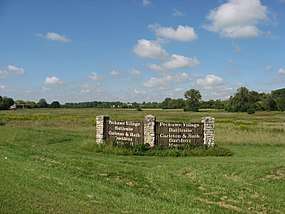Battle of Piqua
| Battle of Piqua | |||||||
|---|---|---|---|---|---|---|---|
| Part of the American Revolutionary War | |||||||
 | |||||||
| |||||||
| Belligerents | |||||||
|
Shawnee |
Kentucky Militia of Virginia State Forces | ||||||
| Commanders and leaders | |||||||
| Unknown | George Rogers Clark | ||||||
| Strength | |||||||
| Unknown | 1,050 militia | ||||||
| Casualties and losses | |||||||
| Unknown (5 alleged to be killed-see link below) |
42 killed + 9 killed/wounded prior to battle {see footnote below} +2 Dow after battle 40 Wounded | ||||||


The Battle of Piqua, also known as the Battle of Pekowee or Pekowi, was part of the western campaign during the American Revolutionary War. Led by General George Rogers Clark, over 1,000 soldiers (among them Daniel Boone and Simon Kenton) crossed the Ohio River near present-day Cincinnati and burned five Shawnee villages, including Old Chillicothe, along the Little Miami River. Peter Loramie's Store, a British trading post-located in what was later Fort Loramie, Ohio in Shelby County, Ohio-, was also burned by Clark's men. The Shawnee gradually withdrew during the first few days before finally engaging American forces 7 miles west of Springfield, Ohio on August 8, 1780.[1] Joseph Rogers, a cousin of George Rogers Clark, had previously accompanied him to Kentucky and was later captured by the Shawnee near Maysville. Despite having been adopted by the tribe, he was killed during the battle while trying to join American forces.[2]
After several hours of fighting, both sides suffered moderate casualties before scattering the small Shawnee rearguard. The campaign against the Shawnee in the Miami River Valley was intended to discourage further raids against Kentucky and other parts of the American frontier, and while no further raids were made by the Shawnee for the remainder of the American Revolutionary War, hostility greatly increased among the tribes living in the Ohio Country for years afterwards.[1]
The battle was the only major engagement fought in Ohio during the American Revolutionary War and a memorial trail and state park, the George Rogers Clark Memorial (39°54′45″N 83°54′30″W / 39.91250°N 83.90833°W) and Tecumseh State Park, was later built on the site of the battle by the Clark County Historical Society.[3][4][5]
An official ceremony was held on the 142nd anniversary to commemorate a monument to George Rogers Clark, an 18 ft. marble statue, as well as the birthplace of Tecumseh. The park was enlarged in 1930 [6] and, on the sesquicentennial celebration of the battle, an historical conference was held at nearby Wittenberg College on October 9, 1930.[7]
References
- Bakeless, John Edwin. Background to Glory: The Life of George Rogers Clark. Philadelphia, Pennsylvania: Lippincott, 1957.
- Barnhart, John D., ed. Henry Hamilton and George Rogers Clark in the American Revolution: With the Unpublished Journal of Lieut. Gov. Henry Hamilton. Crawfordsville, Indiana: R. E. Banta, 1951.
- Barr, Daniel P., ed. The Boundaries Between Us: Natives and Newcomers Along the Frontiers of the Old Northwest Territory, 1750–1850. Kent, Ohio: Kent State University Press, 2006.
- Bond, Beverley W., Jr. The Foundations of Ohio. Columbus, Ohio: Ohio State Archaeological and Historical Society, 1941.
- Flavell, Julie, and Stephen Conway, eds. Britain and America go to War: The Impact of War and Warfare in Anglo-America, 1754–1815. Gainesville: University Press of Florida, 2004.
- Harrison, Lowell Hayes. George Rogers Clark and the War in the West. Lexington: University Press of Kentucky, 1976.
- Hurt, R. Douglas. The Ohio Frontier: Crucible of the Old Northwest, 1720–1830. Bloomington, Indiana: Indiana University Press, 1996.
- James, James Alton. The Life of George Rogers Clark. Chicago, Illinois: The University of Chicago Press, 1928.
- Juday, Richard Roland. The Battle of Piqua: Revolutionary Encounter in Ohio. Dayton, Ohio: Grove-Merrit Publications, 1976.
- Knepper, George. Ohio and Its People. Kent, Ohio: Kent State University Press, 2003.
- Nester, William R. The Frontier War for American Independence. Mechanicsburg, Pennsylvania: Stackpole Books, 2004.
- O'Donnell, James H., III. Ohio's First Peoples. Athens: Ohio University Press, 2004.
- Palmer, Frederick. Clark of the Ohio: A Life of George Rogers Clark. New York: Dodd, Mead & Co., 1930.
- Ricky, Donald B., ed. Encyclopedia of Ohio Indians. St. Clair Shores, Michigan: Somerset Publishers, Inc., 1998.
- Skardon, Mary A. The Battle of Piqua, Aug. 8, 1780: Focal point in Ohio revolutionary history. Clark County Historical Society, 1964.
- Waller, George Macgregor. American Revolution in the West. Chicago: Nelson-Hall, 1976.
External links
- George Rogers Clark papers on 1782 expedition pp. 476–484 Just after crossing the Ohio River a party of 30 men from 2 companies under Hugh McGary encountered Indians while hunting; McGary's casualties were 9 killed/wounded.[8]
- Ohio Moments: 'Savage fierceness' marked Battle of Piqua
- George Rogers Clark and the Battle of Piqua
- account which reports 5 Indians killed and 2 of Clarks men mortally wounded
- The First Century of Piqua Ohio, p. 11 1910 Report of casualties of George Rogers Clark's forces
References
- 1 2 Ohio Historical Society (2005-07-01). "Battle of Piqua". OhioHistoryCentral.com.
- ↑ The American Review: A Whig Journal, Devoted to Politics and Literature. Vol. I. No. 1. New York, 1848. (pg. 609)
- ↑ Mercer, James Kazerta. Ohio Legislative History, 1913–1917. Vol. 5. Columbus, Ohio: F.J. Heer Printing Co., 1918. (pg. 487–488)
- ↑ Torrey, Raymond H. State Parks and Recreational Uses of State Forests in the United States. National Conference on State Parks, 1926. (pg. 213)
- ↑ Campen, Richard N. Outdoor Sculpture in Ohio. Chagrin Falls, Ohio: West Summit Press, 1980. ISBN 0-9601356-2-6
- ↑ Federal Writers' Project. Ohio: The Ohio Guide. Ohio State Archaeological and Historical Society, 1940. (pg. 502)
- ↑ Quife, Milo M. "The Ohio Campaigns of 1782." The Mississippi Valley Historical Review. XVII.1 (January 1930): 515.
- ↑ Rogers and Clark Papers, pp. 477–478